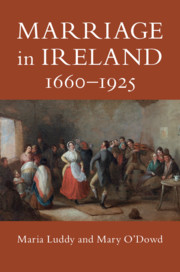Book contents
- Marriage in Ireland, 1660–1925
- Marriage in Ireland, 1660–1925
- Copyright page
- Dedication
- Contents
- Figures
- Illustrations
- Tables
- Acknowledgements
- Abbreviations
- Introduction
- Part I What Is a Marriage?
- Part II Ways to Marriage
- Part III Happy Ever After?
- Part IV The Unmaking of Marriage
- 10 Marital Violence
- 11 Desertion
- 12 Divorce
- Conclusion
- Select Bibliography
- Index
11 - Desertion
from Part IV - The Unmaking of Marriage
Published online by Cambridge University Press: 04 June 2020
- Marriage in Ireland, 1660–1925
- Marriage in Ireland, 1660–1925
- Copyright page
- Dedication
- Contents
- Figures
- Illustrations
- Tables
- Acknowledgements
- Abbreviations
- Introduction
- Part I What Is a Marriage?
- Part II Ways to Marriage
- Part III Happy Ever After?
- Part IV The Unmaking of Marriage
- 10 Marital Violence
- 11 Desertion
- 12 Divorce
- Conclusion
- Select Bibliography
- Index
Summary
Marriage was often a way to contain the poverty of women and children and sometimes men.Men were expected to be the family breadwinners, earning enough to feed, clothe and house their wife and children.In reality, poorer women were always obliged to assist in supplementing or securing the family income, as were children. For many women, the desertion of a husband brought them and their children to destitution and they ended up in the workhouse.Desertion could occur at any point in a marriage, sometimes after a couple of days or even years later. The large number of newspaper notices placed by husbands cautioning the public that they would not pay any bills accumulated by their runaway wives testify to the way in which men and women took matters into their own hands to abandon a difficult marriage, without consulting a lawyer or, in many cases, their spouse.Sometimes spouses agreed to a desertion as a way of separating. The evolution of the law throughout the period saw the removal of legal constraints placed upon women granting them, for instance, greater property rights and economic autonomy.By the end of the nineteenth century, the law provided more substantial support to women who were deserted, or separated, particularly in the area of securing maintenance payments.
Keywords
- Type
- Chapter
- Information
- Marriage in Ireland, 1660–1925 , pp. 350 - 375Publisher: Cambridge University PressPrint publication year: 2020

